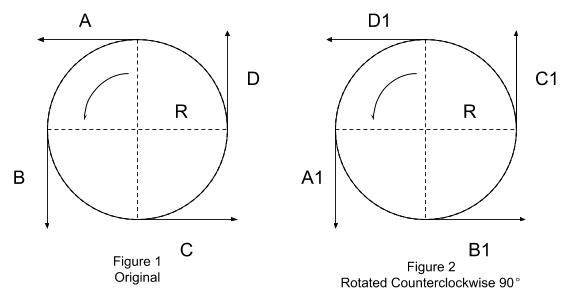“Rotation is changing direction without changing direction”
What kind of confusing statement is that?
Learning taijiquan is a feat in resolving conflicts.
Let’s take at a look at how we can understand the above statement. Figure 1 shows a circle with four tangents (A,B,C and D) at those specific points. A tangent is a straight line that touches the curve at a single point. For any circle, there are an infiinte number of tangents, and each will be perpendicular to the radius (R) of the circle.
Consider that the circle rotates counterclockwise 90 degrees with A moved to A1 position, B to B1 position, and so forth. as depicted in Figure 2. Figure 1 and Figure 2 are actually exactly the same picture. For each of the depicted tangents, there is a 90 degree change in direction. However, overall with the circle itself, there is no change as every tangent still exists in the same way. In other words, every tangent is replaced by another tangent that is exactly the same after any degree of rotation.
Another way of looking at this is that, as rotation happens, if you are sitting on the circumference of the circle, the direction you will be looking at changes all the time, but yet the rotation is continuous in the counterclockwise direction without any interruption nor retreat.
As we extend this concept, we can see other examples in science. For example, there is convervation of energy. Hydroelectricity is setup based on this principle. Water runs down a waterfall. Potential energy is converted to kinetic energy, which drives the turbines with huge magnets wrapped with wires to generate electricity. Through this setup, there is a conversion in energy types, but the total amount of energy remains the same.
Replacing parts in repairs following the same principle. The parts though may be made by different manufacturers must comply with the specification, so that it can be used to produce the same function. So when a new part is put in, the overall function remains the same.
In software development, interfaces are defined so that different implementations can be made in dividual components. These components can be swapped in and out without the callers of the interface noticing any functional change.
In taiji, we are taught to keep contact point(s) fixed. That’s the interface that must remain constant, while we move other body parts not involved in the interface to avoid detection by the opponent. This is the concept of “steal 偷“,e.g. as in stealing a step.
If the opponent is touching the 12 o’clock position of the circle, a counterclockwise rotation will bring him/her to the 10 o’clock position. At this time, he/she will be at the edge of a cliff, and gravity can take over to pull him/her down. The rotation allows no sense of change in him/her, but the relative position is now changed.
http://practicalmethod.com/2020/10/chen-zhonghuas-online-lesson-20201013-online-video-purchase/




{ 1 comment… read it below or add one }
Rotation is changing direction without changing axial direction.